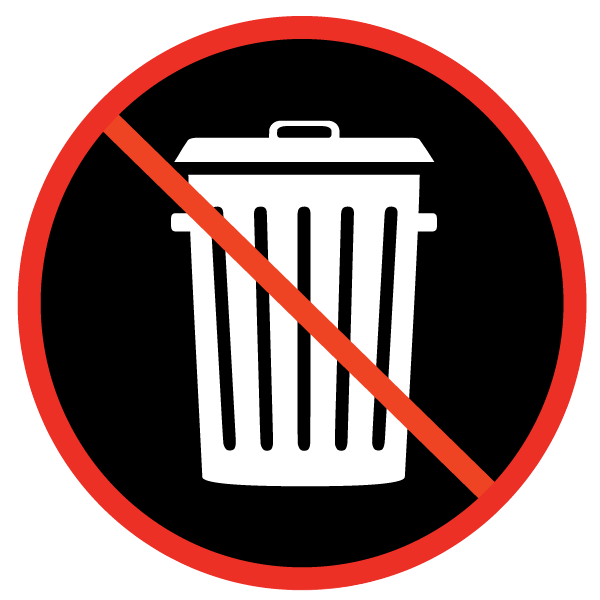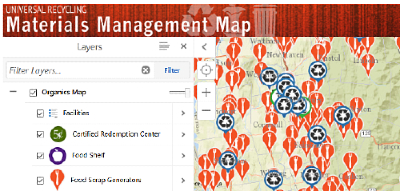State Law Bans Food Scraps from the Trash
Food scraps and yard debris (leaves, grass, brush clippings, etc.) must be managed separately from trash. See our Food Scrap Ban Guidance with requirements for residents, businesses, and haulers.
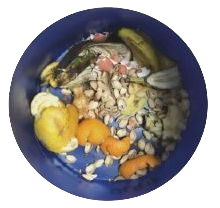
Food scraps are:
- Parts of food items that are typically discarded rather than eaten: peels, rinds, cores, eggshells, seeds, pits, bones, coffee grounds and paper filters, loose-leaf tea & paper tea bags, and fats/oils/grease.
- Food that was not finished: "plate scraps" or leftovers that went bad. Any type of food can become scraps--bread, pasta, soup, veggies, fruit, sauces, meat, dairy, sweets, etc.
These items can go in your food scrap collection container. You may be able to put other items in with your food scraps depending where your scraps end up. Read on to learn more.
Here are some options:
- Compost at home. Read more below about backyard composting and other at-home food scrap management options.
- Drop-off at transfer stations, bad drops, or compost facilities that accept food scraps. Contact your local solid waste experts at 802recycles.com to find learn about options.
- Curbside collection: Check out the list of food scrap haulers in Vermont.
See how real people across Vermont manage their food scraps in the Scrapbook at scrapfoodwaste.org.
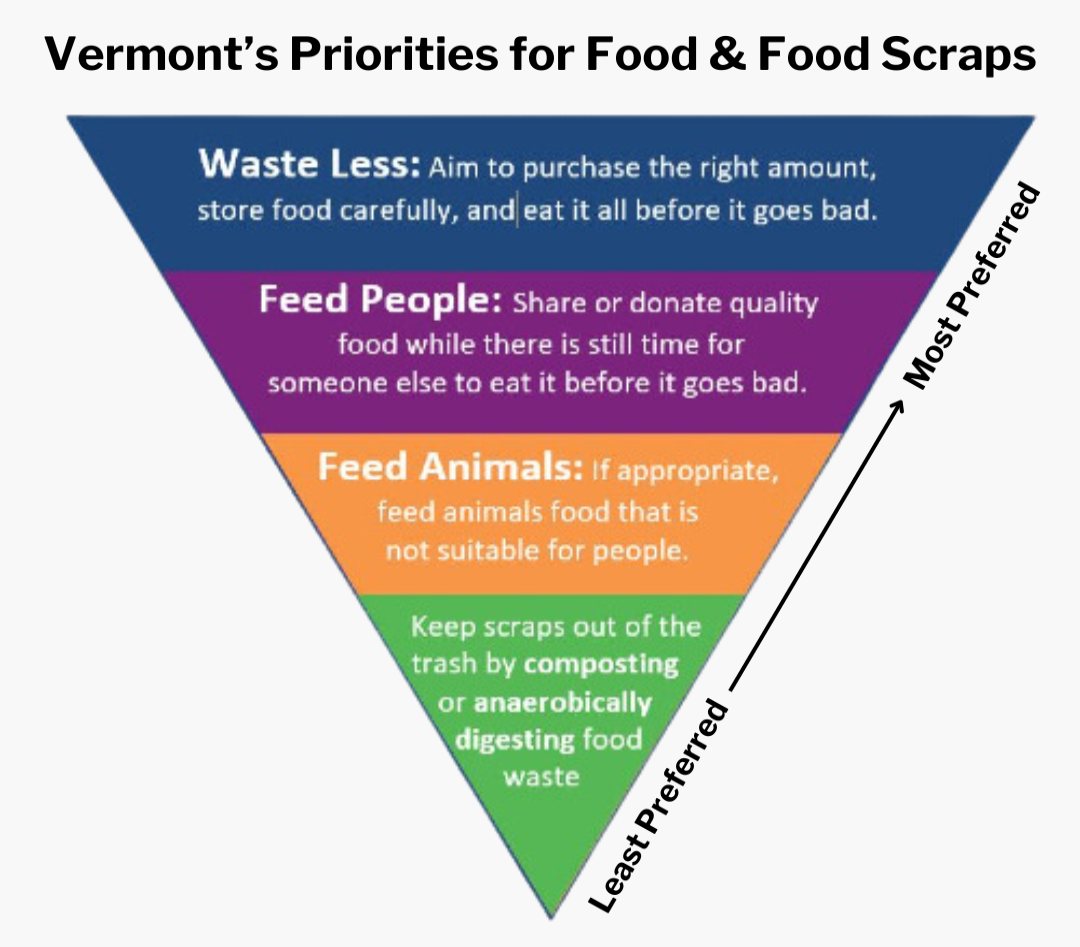
Vermont's Priorities for Food and Food Scraps
Waste Less: Aim to purchase the right amount, store food carefully, and eat it all before it goes bad.
Feed People: Share or donate quality food while there is still time for someone to eat it before it goes bad.
Feed Animals: If appropriate, feed animals food that is not suitable for people.
Keep Scraps Out of the Trash: Food scraps can be composted or anaerobically digested, but never thrown out in the trash!
Collecting food scraps at home.
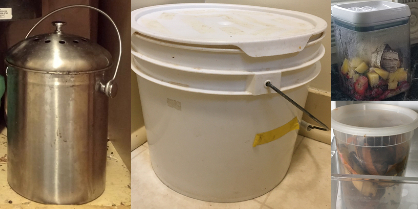 The first step is to collect your food scraps in a container.
The first step is to collect your food scraps in a container.
There are many options for storing food scraps at home. For example:
- Reuse a large yogurt tub or bucket,
- buy a food scrap container,
- keep a plastic bag in the freezer.
Decide which method that works for you based on how much food scraps you create, how often you want to empty and wash your container, etc. You may empty your container regularly if you compost in your yard, or you may have a fixed schedule if you subscribe to a pick-up, or compost at a local drop-off.
Kitchen Tips:

- Use a container with a lid, unless you empty your kitchen container every day or two.
- Wash or rinse your container regularly or each time you empty it.
- To store your food scraps for a while between trips to a drop-off or your pick-up:
- Keep them in a bag or container in your freezer (bread bags work well).
- Try the bokashi process, which ferments the food scraps so they don't smell.
- If you don't mind emptying and cleaning a messier bin, you can store scraps in a larger container with a tight lid (like a 5-gallon bucket) in an out-of-the-way place, like an entryway or garage. To minimize odors, you can cover the food scraps with a thin layer of dried, brown leaves or wood shavings each time you add food scraps.
- Learn more tips in the Food Scrap Management FAQ for Residents.
- Some people use food scrap machines, which grind and dry food scraps, to shrink their food scraps and reduce smell before bringing the food scraps to a local drop-off or composting them in their yard. These machines do not produce a finished compost.
How to Avoid Fruit Flies
There are a few options for deterring fruit flies in your kitchen. Freezing food scraps will stop any odors and will not attract flies. In addition to regularly emptying your food scrap container, and keeping it clean, you can make a simple fly trap.
To make a fly trap:
- Pour a splash of sweet liquid, like red wine vinegar or old wine, in a jar.
- Add a couple drops of dish soap.
- Make a funnel from a piece of paper or cardstock.
Set the funnel in the jar and put the jar next to your food scrap container. Make another one to keep by your fruit.
Why separate food scraps from the trash?
Food scraps and yard debris make up around 30% of a typical Vermont family’s waste. At restaurants and cafeterias, food scraps can be over half the waste. Keeping food scraps out of the landfill has a big impact:
- When it is trapped in a landfill, food waste decomposes slowly, and without oxygen. This process produces methane, which is a greenhouse gas 84 times more powerful than CO2 over a 20-year period.
- Food scraps contain valuable nutrients that are good for the soil. Finished compost can be used in gardens, farms, and landscaping.
- Without food scraps in it, garbage is cleaner and less smelly.
- Generating less trash conserves landfill space.
- Composting puts your waste to work supporting composters, local farmers, and food scrap haulers.
How does food waste relate to climate change?
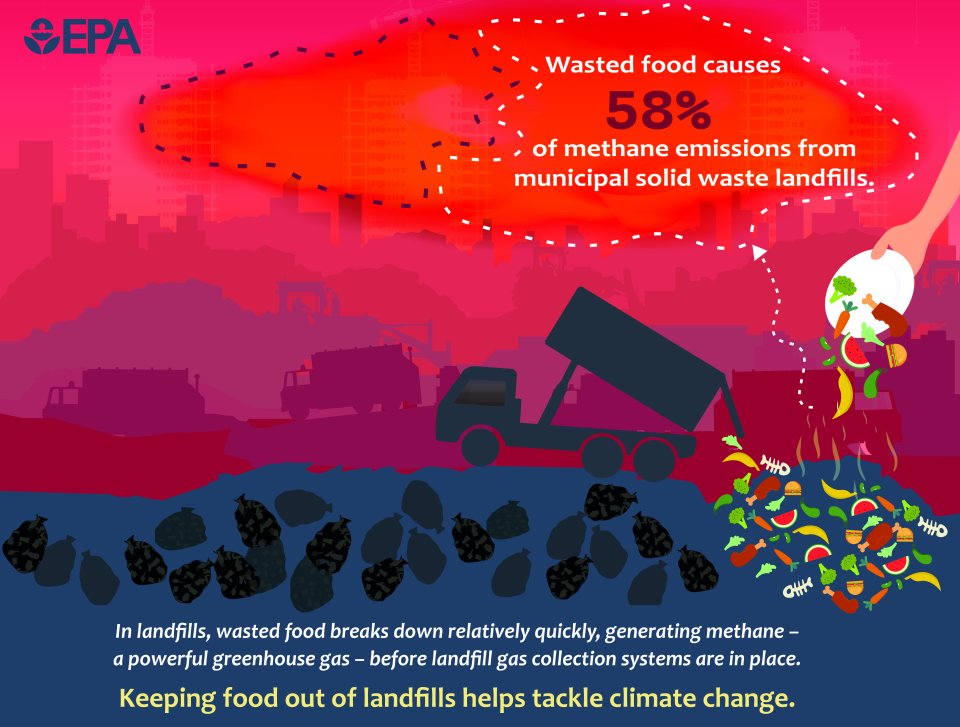 According to Project Drawdown, uneaten food contributes 8% of the world's total greenhouse gas emissions, and reducing food waste is one of the single most impactful actions for reducing the effects of climate change. Composting food scraps is also an important climate solution.
According to Project Drawdown, uneaten food contributes 8% of the world's total greenhouse gas emissions, and reducing food waste is one of the single most impactful actions for reducing the effects of climate change. Composting food scraps is also an important climate solution.
The US EPA estimates that 58 percent of methane emissions released to the atmosphere from municipal solid waste landfills are from landfilled food waste. Methane is created in landfills as organic wastes break down under anaerobic conditions. This is true even in landfills that collect landfill gas to produce electricity. Municipal solid waste landfills are the third-largest source of methane emissions from human activities in the United States.
 How can I waste less food?
How can I waste less food?
The EPA estimates that households account for 40% of all wasted food in the United States, making it the largest single-source of wasted food in the country. Food waste is also expensive, costing the average family over $1,500 per year.
Here's some tips to help you reduce wasted food at home:
- Regularly clean our your refrigerator, freezer, and pantry.
- Plan out meals before shopping.
- Before going to the grocery store, shop your pantry, and create a shopping list.
- Buy only what you need.
- Understand that date labels are not regulated (except for infant formula). Just because a food is past date, does not mean it is unsafe to eat.
- Store leftovers in clear containers and eat them before they go bad.
Learn more at scrapfoodwaste.org.
External resources:
Drop-Off Food Scraps at a Collection Location
Remember to ask your drop-off facility what materials they accept.
You can drop off food scraps and yard debris at any transfer station or bag-drop in Vermont. Many compost facilities also have drop-offs. Consult your local Waste Management District or town or our Materials Management Map to learn about services in your area.
Curbside Food Scrap Pick-Up Services
Remember to ask hauler what materials they accept.
Residents and businesses looking for curbside services can ask your hauler if they offer food scrap pick-up, or find a hauler on the statewide list of food scrap haulers. Some haulers offer bear-resistant containers to customers. Check out these other tips for keeping bears away from food scrap and trash containers. In Vermont, hauling food scraps for a fee requires a state hauler permit.
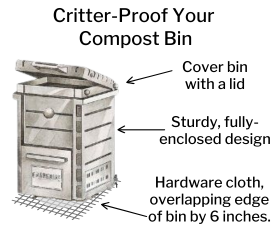 Backyard Composting
Backyard Composting
To get started with on-site composting, read The Dirt on Compost, take the Vermont Master Composter Course, attend a composting workshop, or explore the other resources at the bottom of this page.
Make your own bin or purchase a container (some solid waste districts or towns offer free workshops and discounted bins). Your bin should be enclosed and sit on top of wire-mesh hardware cloth, so animals, including dogs, can't get in.
Cover every bucket of food scraps ("greens") with three buckets of dried yard debris (“browns”), like leaves, dry grass, sawdust, or chipped wood. Covering food scraps with browns creates the appropriate carbon to nitrogen ratio for soil bacteria and other decomposers to break down the pile and reduces odors.
Once the material has decomposed for months, it will begin to look like soil. You can speed up the decomposition process and prevent odors by mixing the pile once in a while. Your compost will be ready to use when there is no visible food scraps left (i.e., looks like soil) and the pile is cured. Curing is the final stage of the compost process when material looks finished, but there is still some nutrients which need to be balanced by microorganisms. Simply allow finished compost to continue maturing for a few months before using in gardens or landscaping. To see if compost is cured and ready for use, you can do a scent check using a plastic bag.
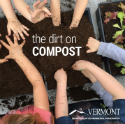 If you compost in a backyard, the law allows you to throw meat, bones, and grease in the trash (including seafood). These items don't break down quickly in small-scale compost systems.
If you compost in a backyard, the law allows you to throw meat, bones, and grease in the trash (including seafood). These items don't break down quickly in small-scale compost systems.
What about bears and other animals?
- Meat and bones can attract animals, so don't compost them in your backyard bin. Cover food scraps completely with dry, brown plant material to contain any smells.
- Take down birdfeeders, except when bears are hibernating in the deep winter. Bird seed draws bears into yards.
- Secure your trash, feed pets indoors,
- Protect chickens and honeybees with electric fences.
- Learn more about backyard composting in bear country and other strategies to live safely with black bears from the Vermont Fish & Wildlife Department.
- Keep dogs out of the compost or food scrap bin. They can get very sick if they eat decomposing food scraps.
Digest Food Scraps in your Yard
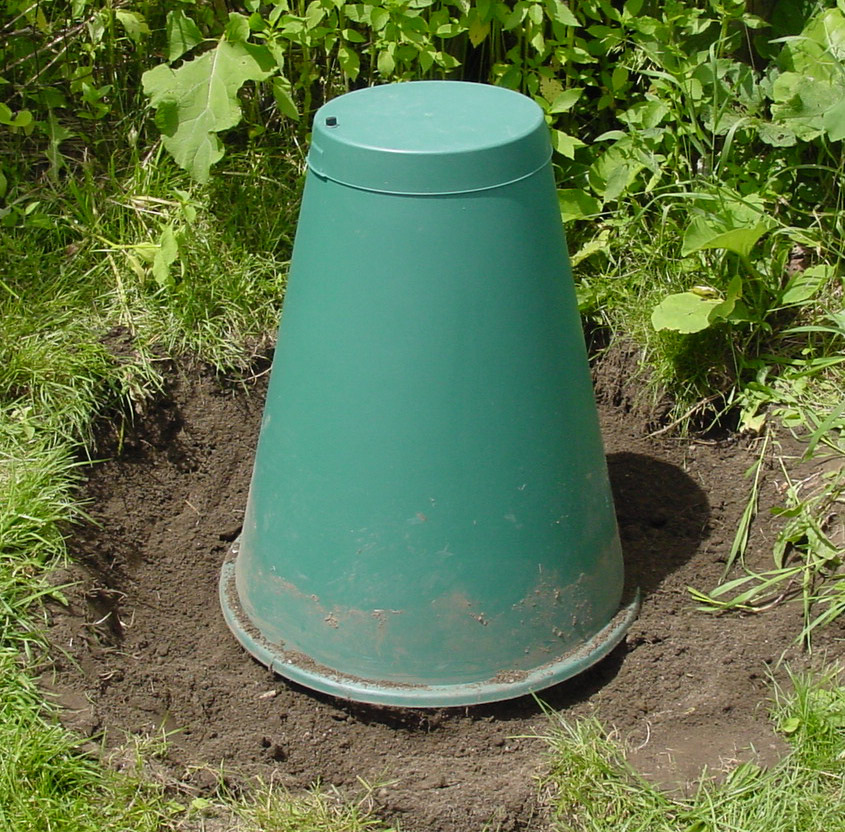 Solar digesters use the sun's energy to break down food scraps. Food scraps are placed in a container dug into the ground and the scraps slowly release nutrients as they break down. Digesters work best in well-drained soil.
Solar digesters use the sun's energy to break down food scraps. Food scraps are placed in a container dug into the ground and the scraps slowly release nutrients as they break down. Digesters work best in well-drained soil.
Solar Digesters differ from backyard composting in a variety of ways. For instance, they:
- decompose waste material almost completely,
- do not require brown materials to decompose food scraps,
- do not produce a finished compost product,
- can break down meat, bones, pet waste, and other animal products.
Similar to backyard composting, the law allows you to throw meat, bones, and their fats (including seafood) in the trash if you digest food scraps at home.
You may be able to purchase a solar digester from your waste district or town. Also, there are some great DIY designs available, like this version made with a galvanized metal trash can.
Feeding Food Scraps to Animals
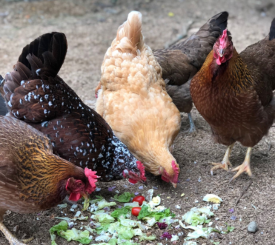 If you have chickens or pigs, you can feed household scraps to them.
If you have chickens or pigs, you can feed household scraps to them.
To prevent the spread of diseases, the Agency of Agriculture prohibits feeding pigs food scraps that have touched meat or fish, including their organs, bones, and juices. These regulations do not apply to feeding personal food scraps to pigs that are for personal consumption. To learn more, consult Feeding Food Scraps to Pigs and the Agency of Agriculture's Guidance on Feeding Food Scraps to Pigs.
The Agency does allow feeding food scraps to chickens, at a small scale.
Some food scraps from food manufacturing, such as spent brewery grain and whey, can also be fed to animals.
Vermicomposting (composting with worms) is a great small-scale, indoor composting options. Cornell University offers a robust library of resources on vermicomposting, including how to build and maintain a vermicompost bin, and how to harvest and use finished castings.
What happens to the food scraps I've separated?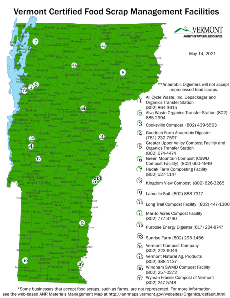
If you compost with a local drop-off program or through a curbside hauler, you may wonder where your food scraps are composted. Most of Vermont’s food scraps are composted at composting facilities. Some food scraps are fed to animals or processed at anaerobic digesters. Click on the map to view facilities around the state.
Many Vermont compost facilities sell their finished compost. On-farm composters are required to use at least half of their finished compost on their own farms.
What if I still have questions?
Check out our Frequently Asked Questions handouts for residents, businesses & institutions, landlords, condo associations, and resorts, hotels, and other lodging establishments, or explore the resources at the bottom of this page. You can also contact your local solid waste district or town or VT DEC (at 802-828-1138; ANR.ScrapFoodWaste@vermont.gov) with questions or for no-cost assistance.
Vermont Compost Operator Training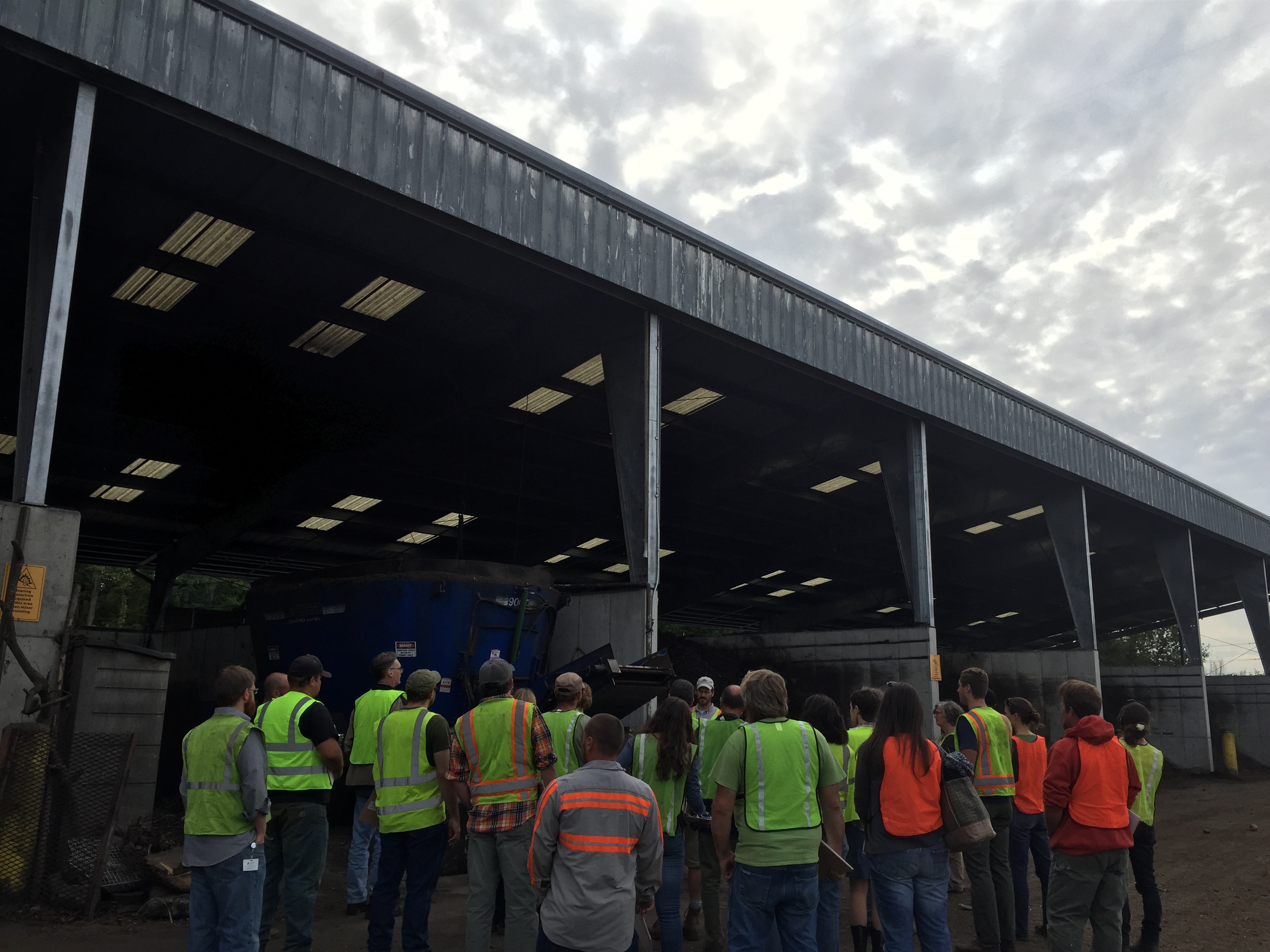
If you are interested in operating a certified compost facility in Vermont or you want to increase your larger-than-backyard-scale composting knowledge, sign up for the one-day Vermont Compost Operator Course (~$30 course fee). To put your name on the contact list for the next training, go to Compost Technical Services' website. For backyard composting training, contact your local waste district or town or sign up for the Vermont Master Composter Course.
Residential/General Resources
- Compost with Confidence: An introduction to composting options and methods in VT
- The Dirt on Composting: An in-depth guide to composting in your backyard
- For Residents: Managing Food Scraps FAQ
- Vermont Master Composter Course: An in-depth online composting class
- Community Composting Resources
- Don't Put Food Scraps Down the Drain
- Infographic: Benefits of Keeping Food Waste out of the Landfill
- Benefits of Redirecting Food Scraps from Landfills
- Managing Food Scraps in the Kitchen (useful handout for tenants; similar to the website)
- Tips & FAQs for Condo Associations
- Backyard Composting Workshop Slideshow
- Food Scrap Collection Poster for Rentals & Condos: Food Scraps Only
- Food Scrap Collection Poster for Rentals & Condos: Paper and Certified-Compostable Plastics Allowed
- Food scrap tracking guide, tracking sheet, and log sheet
Business/Hauler/School Resources
- Defining Food Residuals--Is this banned from the trash?
- FAQs for Businesses/Institutions
- For Small Businesses: Managing Food Scraps FAQ
- For Landlords: Managing Food Scraps at Rentals FAQ
- For Haulers: Bearproofing Trash and Food Scrap Containers Guide
- Managing Trash and Food Scrap Carts in Bear Country
- Managing Food Scraps at Businesses
- Managing Food Scraps and Recycling at Resorts and Other Lodging
- Reducing Food Waste at Businesses
- EPA Guide to Conducting and Analyzing a Food Waste Assessment
- Resorts Food Scrap Management Success Story
- How to Haul Food Scraps
- Small-Scale Food Scrap Hauler Budget Template (from Lake Champlain Sea Grant)
- School Composting Guidance
- Managing Food Scraps at Facilities and Drop-Offs


